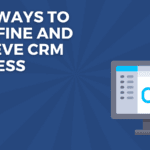Two Ways to Redefine & Achieve CRM Success

Getting professionals to input or manage contacts in the CRM has always been a major goal and challenge for businesses. Firms have long struggled to convince users to consistently enter and maintain contact data. We think it is time to reset those unrealistic expectations and redefine the concept of CRM adoption and success.
As CRM Success consultants, we ask every client with whom we work, “What does CRM success look like for you?” Asking this important question allows us to uncover stakeholders’ definition of success, uncover pain points and see where they are currently versus where they would like to be. Some answers we commonly receive are:
- fewer manual processes
- less reliance on spreadsheets
- greater efficiency
- better sharing of information
But the answer we hear most frequently is to increase attorney adoption. Adoption, by their definition, is having more attorneys actively contributing contacts to the system, looking up information, running reports on their own and – ideally – adding activities and notes to contact records. (Spoiler alert: most attorneys don’t have time for this!)
The “CRM Adoption = CRM Success” Paradigm
So, how did we get to the point of expecting lawyers to actually use CRM? In short, it is the lawyer’s valuable information in the system – their contacts, their clients and their relationships. CRM systems are entirely dependent upon the existence of clients and relationships, and that information is entirely dependent on lawyers (or someone on their behalf) entering them into the CRM system.
As marketing technology has evolved from having attorneys and professionals enter contact data manually to automatically syncing contact data from contact books or other sources, many firms haven’t taken advantage of new technology. They are left with diminishing returns as fewer and fewer contacts are being entered into the CRM.
Further, many lawyers tend to not keep up with their contact records. Relying on their last contact point with the client, lawyers often search for the email and click reply or find the phone number in the signature block. All in all, CRM strategies that rely on lawyers updating records – regardless of the effort involved – are becoming more and more inaccurate and underpopulated over time.
The “CRM Adoption” Reality
The truth is that firms that define CRM success by this definition of adoption are setting themselves up for failure. Why? Because in law firms, time is money, literally! Lawyers don’t think the best use of their billable hours is spent entering and updating contact data (and we agree). This is a major reason why respected research organizations say 70% of CRM implementations fail to meet expectations.
But CRM failure isn’t always the fault of lawyers or the technology, it’s often because expectations were too high. Leaders within the firm expect their data to be clean correct and updated, and when it isn’t they consider the CRM implementation to be a failure. After seeing firsthand so many “failed” CRM implementations from hundreds of firms, it is time we redefine system usage and mitigate expectations.
CRM Success Redefined
The good news is that many of the newer CRM systems have similar abilities as ERM systems. ERM – which stands for Enterprise Relationship Management – is the ability to automatically capture contact data from signature blocks and dynamically calculate who-knows-who relationships based on the recency and frequency of communication. This allows lawyers to be lawyers and not spend as much time using the system or manually entering contact data.
Rather than defining adoption by the number of professionals actually using the CRM, adoption can be defined as using CRM data to make informed business development decisions and help manage relationships with clients and prospects.
Once you’ve redefined what CRM success looks like it’s important to set measurable and achievable goals to help mitigate expectations. Try bringing in new data sets, the availability of new reports that can impact your end users day-to-day or finding new ways to provide value to users.
But redefining and achieving CRM success can be a difficult task for firms to manage. Switching the paradigm from users entering data to users leveraging data poses a few challenges. Training strategies must be adapted to accommodate the new uses of CRM along with the communication strategy being adjusted for communicating the new goals you’d like the CRM to achieve.
If you need help adopting your communication or training strategy, CLIENTSFirst Consulting is here to help. For more than 10 years, the team at CLIENTSFirst Consulting has been helping professional services firms and other organizations successfully select and implement CRM and eMarketing systems and improve Data Quality to maximize value, adoption and return on investment. If you need help achieving CRM Success, please contact us at 404-249-9914 or Info@CLIENTSFirstConsulting.com.






